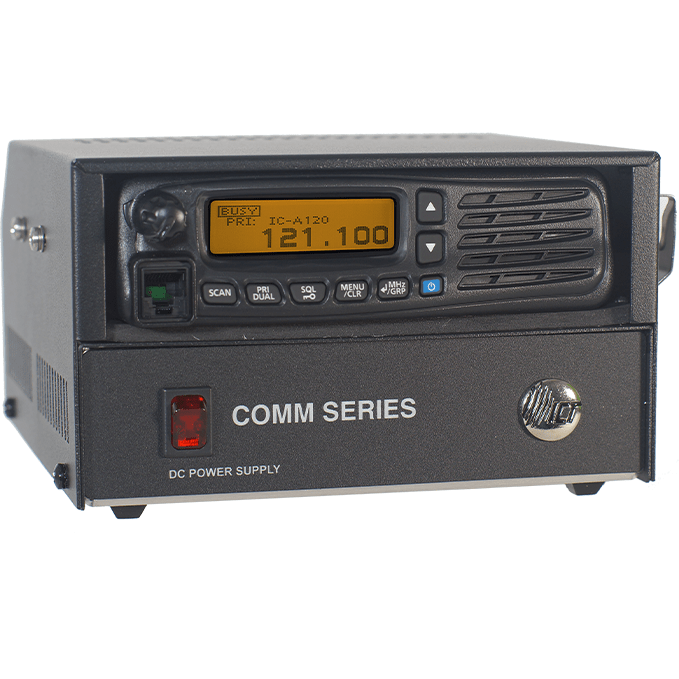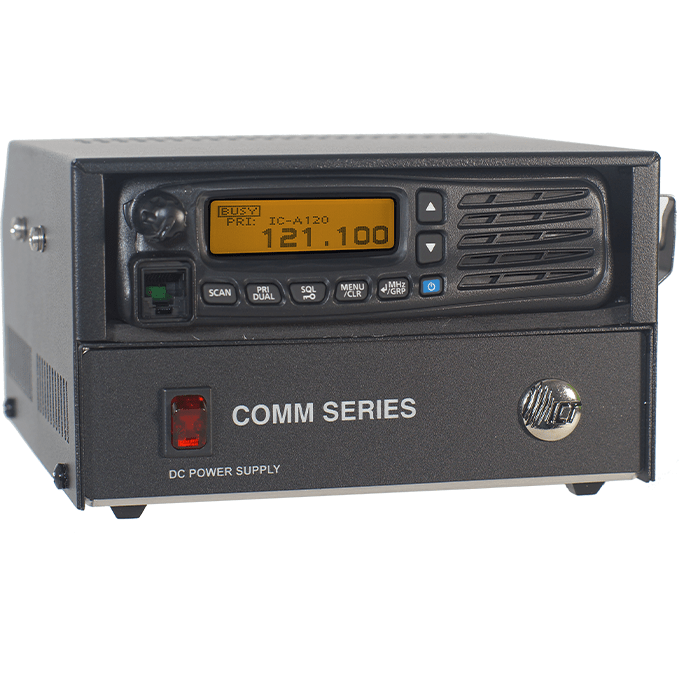Você já ficou curioso sobre o que pilotos e controladores de tráfego aéreo estão dizendo uns aos outros? Bem, ouvir o controle de tráfego aéreo (ATC) em um scanner é definitivamente uma maneira fascinante de mergulhar na comunicação da aviação e aprender mais sobre como se comunicar adequadamente com o ATC.
Talvez você seja um piloto estudante em treinamento ou apenas tenha interesse em aviação. Não importa quais sejam seus objetivos, este guia o guiará por tudo o que você precisa saber sobre como ouvir o ATC em um scanner.
RESUMO
-
Você pode ouvir legalmente as transmissões de controle de tráfego aéreo nos EUA como um civil.
-
É necessário um scanner ou receptor com acesso às frequências de aviação.
-
Entender o jargão e as frequências do ATC pode melhorar sua experiência auditiva.
-
Aplicativos e sites digitais também fornecem acesso a transmissões ao vivo do ATC.

Que equipamento você precisa para ouvir o ATC?
Se você quiser ouvir o controle de tráfego aéreo, precisará de um scanner ou rádio scanner capaz de receber sinais de Frequência Muito Alta (VHF) na banda de aviação.
Vamos dar uma olhada em que tipo de equipamento você precisa:
-
Scanners ou Rádios
Você precisará procurar um scanner que suporte frequências de ar entre 118.000 e 136.975 MHz . Existem ótimos modelos portáteis, como os rádios Uniden Bearcat ou Icom. Essas são geralmente as escolhas mais populares.
-
Smartphones ou Computadores
Existem aplicativos fantásticos como o LiveATC.net , que permitem que você transmita comunicações ATC do seu telefone ou computador.
É uma alternativa conveniente se você não quer investir em equipamento físico, mas quer ouvir voos comerciais ou ouvir uma autorização de decolagem e pouso.
Você também pode monitorar facilmente diversas frequências abrindo abas do navegador.
Apenas tenha em mente que há um atraso com o LiveATC. De acordo com as Perguntas Frequentes do LiveATC, o atraso geralmente é menor que 20 segundos para a maioria dos ouvintes. O atraso é afetado pelo feed específico e sua conexão. Alguns usuários relataram atrasos variando de 10 a 45 segundos.
-
Configuração da antena
Uma antena de alta qualidade melhora a recepção do sinal. Posicione-a em uma área aberta ou perto de uma janela para obter os melhores resultados.
Depois de ter seu equipamento ou aplicativo, sintonize as frequências do ATC do aeroporto mais próximo para começar a ouvir.

Como encontrar frequências ATC
O ATC opera em uma ampla gama de frequências, mas encontrar as corretas é muito mais fácil do que você pensa. Siga estes passos:
-
Comece com informações do aeroporto
Verifique recursos online como o FAA's Chart Supplement Search , SkyVector ou AirNav para encontrar frequências específicas para seu aeroporto local.
-
Entenda o básico
As frequências ATC são divididas em setores, como Ground, Tower, Approach e Departure . Saber qual frequência sintonizar depende do tipo de comunicação que você quer ouvir.
-
Digitalizar manualmente
Se seu scanner tiver uma função de busca, você pode simplesmente escanear a banda de aviação até pegar transmissões. Esta é uma ótima maneira de descobrir novas frequências.
-
Monitorar frequências comuns
Muitos aeroportos usam frequências padrão para ATIS (Automated Terminal Information Service) ou Ground Control que são fáceis de encontrar. Com aeroportos pequenos ou aeroportos não controlados, você pode ouvir os pilotos se comunicando diretamente uns com os outros na Common Traffic Advisory Frequency (CTAF) para a área.

Tipos de comunicações de aviação
Ao sintonizar, você acabará encontrando vários tipos de transmissões. Diferentes categorias fornecerão diferentes tipos de coisas que você pode ouvir:
-
Tráfego Aeroportuário e Controle de Solo
Elas cobrem movimentos de aeronaves no solo e nas proximidades do aeroporto. Aeroportos movimentados podem ter controladores separados para operações norte e sul.
-
Controle de tráfego em rota
Isso envolve a comunicação entre pilotos e Centros de Controle de Tráfego Aéreo (ARTCC) enquanto os aviões viajam pelo país.
-
Comunicação ar-ar
Isso é informal e usado para coordenação de localização e comunicação. Os pilotos podem conversar entre si, especialmente em áreas remotas.
-
CTAF (Frequência Comum de Aviso de Tráfego)
Usado em aeroportos sem torres para pilotos anunciarem posições e intenções.
-
Operações terrestres
Isso inclui comunicação com serviços como abastecimento, degelo e veículos de manutenção.
Cada uma dessas categorias tem frequências dedicadas, e aeroportos maiores podem ter vários canais para cada função.

Frequências AWOS, ASOS e ATIS
Para apreciar completamente as comunicações de aviação, é útil ouvir atualizações meteorológicas e operacionais automatizadas. Aqui está uma rápida visão geral desses sistemas:
-
AWOS (Sistema Automatizado de Observação Meteorológica)
O AWOS fornece atualizações meteorológicas contínuas, incluindo temperatura, velocidade e direção do vento, pressão barométrica e visibilidade. Esses sistemas são normalmente encontrados em aeroportos menores e são usados por pilotos que planejam suas aproximações.
-
ASOS (Sistema Automatizado de Observação de Superfície)
O ASOS relata dados meteorológicos semelhantes aos do AWOS, mas com informações adicionais, como condições do céu e tipo de precipitação. Ele é frequentemente usado em aeroportos maiores e se integra aos sistemas do National Weather Service.
-
ATIS (Serviço Automatizado de Informações de Terminais)
O ATIS transmite atualizações gravadas sobre o clima local, condições da pista e outras informações relevantes. Os pilotos sintonizam o ATIS antes de contatar os controladores de solo ou da torre. As atualizações recebem um código de letra (como “Information Alpha”) para confirmar que os pilotos têm as informações mais recentes.
Você pode encontrar essas frequências em mapas de aeroportos ou em recursos online.

|
Icom IC-A120 - Transceptor de banda aérea VHF - Estação baseAumente a eficiência da sua comunicação com o Icom IC-A120 repleto de recursos, projetado para operações de voo. 
|
Dicas para ouvir
Ouvir o ATC pode ser uma ótima ferramenta de ensino para pilotos estudantes e para aqueles em treinamento para se tornarem controladores de tráfego aéreo. Aqui estão algumas dicas para aproveitar ao máximo sua experiência:
-
Aprenda o jargão
Familiarize-se com as frases e terminologias comuns do ATC. Aqui estão algumas:
Fraseologia
Significado
Autorizado para decolagem
Autorização para sair da pista.
Segure curto
Instrução para parar antes de chegar a um ponto específico, como uma pista.
Autorizado para pousar
Autorização para pousar na pista especificada.
Ir ao redor
Aborte o pouso e prepare-se para tentar novamente ou siga as instruções do ATC.
Faça fila e espere
Taxie para a pista e mantenha a posição para liberação posterior.
Grito XXXX
Defina o transponder para o código de quatro dígitos especificado.
Descer e Manter
Comece a descida até a altitude atribuída e mantenha-a.
Escalar e Manter
Suba até a altitude designada e mantenha-a.
Rogério
Confirmação de transmissão recebida.
Espera
Aguarde novas instruções; não há necessidade de responder.
Tráfego à vista
O piloto identificou visualmente a aeronave mencionada.
Impossível
Não foi possível cumprir a instrução devido a limitações operacionais.
Wilco
"Cumprirá" a instrução recebida.
Contato [Nome da instalação]
Mude a frequência de rádio para a instalação especificada (por exemplo, Torre ou Aproximação).
A FAA fornece um ótimo recurso para fraseologia de comunicação de rádio .
-
Categorias de comunicação ATC
Ao sintonizar, você encontrará vários tipos de transmissões:
-
Airport Traffic and Ground Control: Estes cobrem os movimentos de aeronaves no solo e nas proximidades do aeroporto. Aeroportos movimentados podem ter controladores separados para operações norte e sul.
-
Controle de Tráfego em Rota: envolve a comunicação entre pilotos e Centros de Controle de Tráfego Aéreo (ARTCC) enquanto os aviões viajam pelo país.
-
Comunicação ar-ar: geralmente informal e usada para coordenação, os pilotos podem conversar entre si, especialmente em áreas remotas.
-
Operações terrestres: incluem comunicação com serviços como veículos de abastecimento, degelo e manutenção. Cada uma dessas categorias tem frequências dedicadas, e aeroportos maiores podem ter vários canais para cada função.
-
-
Comece Simples
Comece com aeroportos menores, onde as transmissões são mais fáceis de ouvir.
-
Tome notas
Anote indicativos ou instruções interessantes para pesquisar mais tarde.
-
Pratique a paciência
As comunicações do ATC podem parecer rápidas no começo, então seja paciente e persista.
-
Respeite a privacidade
Lembre-se, ouvir é para educação e entretenimento. Evite compartilhar gravações sem permissão.
Aplicativos e sites para escuta ATC
Se você preferir pular o hardware, as ferramentas digitais facilitam ouvir o ATC em qualquer lugar:
-
LiveATC.net
Uma das plataformas mais populares para transmissões ao vivo de controle de tráfego aéreo.
-
Transmitir
Oferece feeds para vários canais de segurança pública e aviação.
-
Canais do YouTube
Muitos entusiastas da aviação carregam gravações reais do ATC.
Esses recursos são especialmente úteis para ouvir comunicações internacionais do ATC ou de hubs movimentados como JFK ou LAX.

Perguntas frequentes
-
Os civis podem ouvir o controle de tráfego aéreo?
Sim, é perfeitamente legal na maioria dos países, incluindo os EUA, desde que você não esteja transmitindo as transmissões. -
Qual é o melhor scanner para ATC?
O Uniden Bearcat BC125AT e o Icom IC-R6 são populares por sua facilidade de uso e desempenho confiável. -
Por que a comunicação do ATC é tão rápida?
Pilotos e controladores usam frases concisas e padronizadas para se comunicar claramente. -
Preciso de uma licença para ouvir o ATC?
Não é necessária licença para ouvir. No entanto, transmitir em uma frequência de torre de controle de tráfego aéreo é ilegal sem a devida certificação.
Remover
Agora que você sabe como fazer isso, ouvir o controle de tráfego aéreo abre um mundo totalmente novo de insights sobre aviação. Pegue seu scanner, encontre suas frequências locais e divirta-se ouvindo como a comunicação da aviação funciona!
Interessado em comunicações de aviação?
Nossos guias foram projetados para ajudar!
-
Frequências comuns da aviação: um guia de comunicação para pilotos
-
Como voar em um padrão de tráfego em um aeroporto sem torres
-
Perda de comunicações em voo IFR (o que fazer e procedimentos a seguir)
Você achou este artigo útil?
Você acha que esquecemos de uma pergunta importante da entrevista? Deixe-nos saber nos comentários abaixo!







